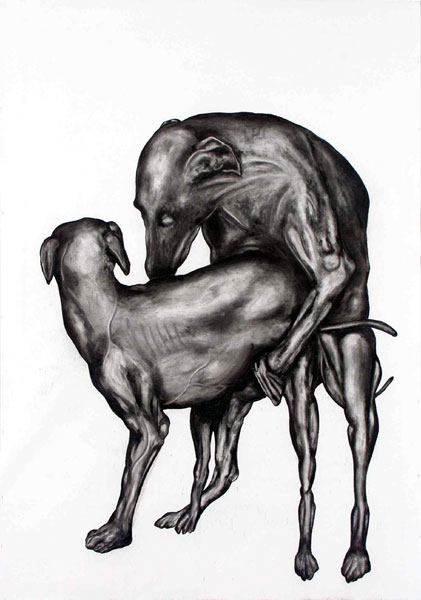MIKA KARHUDrawings 17.10.2002 – 10.11.2002
 Noble race, 2002
Noble race, 2002charcoal on paper
220 x 155 cm
Black and white world
Time and again, Mika Karhu's charcoal drawings make me feel ill at ease. Something is obviously very badly wrong and needs putting right. I just cannot put my finger on what it is, let alone think what ought to be done to make things better. I do know that the problem lies not with the image and will thus not disappear by changing the picture - the fault lies with the world that the image portrays.
Anxiety is born of something lurking beyond the frame, something whose menace grates on the soul but cannot be pinned down. The pressing force cannot be caught, or fought. There is no certainty even of its existence except in one's own mind. That is why it is best to remain silent, in fear of shame and being branded paranoid - a mind as grey as an underpass chilled by the wet slush of November.
The creatures in Karhu's drawings are often floating loosely in their own, literally black and white reality, without any contacts or background. In addition, they seem totally passive and helpless, unable to influence in any way the forces that have made them what they are.
On a bad day, the drawings reflect one's own image. The expectations, obligations, limitations, hopes and urges vaguely churning in the culture surrounding us mould our minds and bodies in unpleasant directions. At the same time, though, we know that an alternative is difficult to imagine. What might more natural or correct expectations, hopes and urges be? And am I not just as responsible as anyone else for the course our culture has taken?
Karhu's drawings are enticing in that despite their visual lack of colour they are anything but black and white on a conceptual level. They exhibit clear criticism of the entire culture around us, whilst simultaneously projecting acceptance of the inevitable, dealing with the situation. If the world, and we as part of that world, can be compressed into this, then let us try and find something good in it - good in this case referring to occasional tranquillity and humour.
Theodor Adorno posited
that the duty of art was to create a kind of physical unease that would
encourage viewers to seek a better world without succumbing to simplifying
declarations. According to this point of view, bad art is art that, by its
entertainment value, numbs viewers into accepting the status quo, with all
of its negative aspects. Karhu manages, as if by magic, to accommodate both
incitement to a critical sense of restlessness and deadening acceptance
within a single image. In its duality, the setting is not unlike that of
traditional vanitas paintings - in Karhu's world, however, the final dividing
line of black and white, that which is in vain and that which is of essence,
remains undrawn.
Ossi
Naukkarinen
